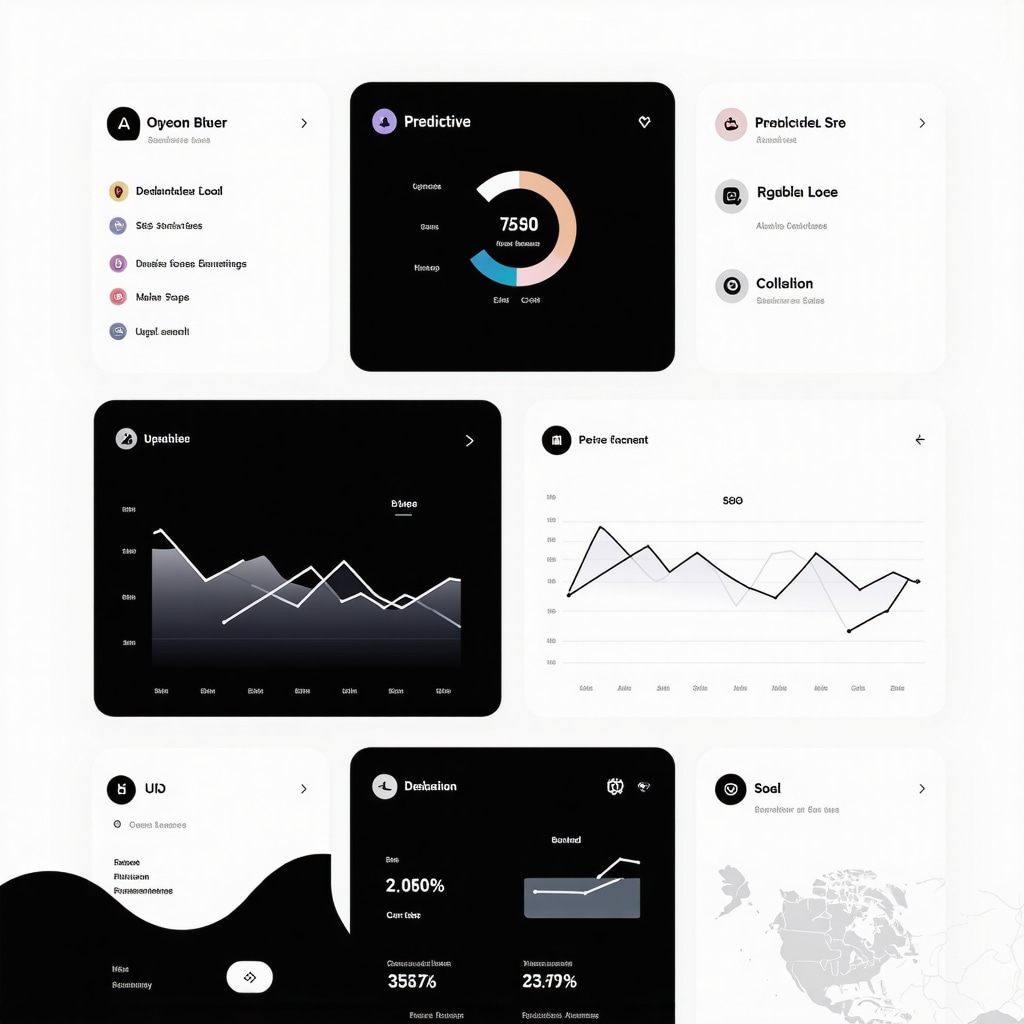Unlocking the Power of Google My Business Insights
In an era where local searches dictate foot traffic and sales, mastering how to track and analyze your Google My Business (GMB) performance is not just a luxury but a necessity. Understanding the nuances behind your GMB metrics can transform your local presence, driving continuous growth and sustainable customer engagement. This guide dives into expert strategies for gleaning actionable insights from your GMB profile, helping you stay ahead in the competitive local landscape.
Decoding Key Metrics That Drive Local Success
Google My Business provides a wealth of data, but not all metrics are created equal. Focus on understanding customer actions like direct calls, website visits, and direction requests, which directly signal engagement levels. Additionally, monitor search queries revealing how users find your listing, whether through direct brand searches or discovery via category keywords. These insights help refine your local SEO strategy and content optimization. For example, if “best local cafes” leads to your profile, enhancing your GMB description with related keywords can amplify visibility.
How Can You Leverage GMB Insights to Outperform Local Competitors?
Analyzing competitor GMB profiles alongside yours can uncover gaps and opportunities. Utilize tools such as Google’s own Google My Business Insights to benchmark your performance. Notice if competitors receive more photo views or have higher review interaction rates, and strategize accordingly by improving your visual content or boosting customer review generation. Practical application of these insights, combined with periodic audits like those detailed in our GMB SEO Audit guide, ensures your listing stays optimized and competitive.
Practical Tools and Techniques for In-Depth Analysis
Beyond native GMB analytics, integrating third-party SEO tools such as SEMrush or Moz can provide a fuller picture by tracking keyword rankings, local citation consistency, and backlink profiles linked to your GMB listing. Regularly tracking these indicators uncovers trends and potential ranking issues before they impact visibility. For instance, fluctuations in citation data might suggest inconsistent business information across directories, which can be addressed through expert citation management services like those offered at RankingSEO GMB.
Fostering Continuous Growth Through Iterative Optimization
Performance tracking should translate into action: update your business descriptions with targeted keywords, refresh photos regularly, and engage actively with reviews to build trust and relevance. Implementing weekly or monthly GMB posting schedules keeps your audience engaged and signals to Google that your listing is active and authoritative. Discover detailed methods in targeted GMB updates that drive ongoing local visibility improvements.
Call to Action: Share Your GMB Growth Journey
Have you tried specific metrics or tools to enhance your GMB performance? Share your experiences and challenges in the comments below — your insights could inspire others navigating local SEO success!
Diving Deeper Into Customer Behavior Insights
One of the most eye-opening moments in my journey optimizing Google My Business was truly understanding the story behind customer actions. For example, when I noticed a spike in direction requests during weekend mornings, it wasn’t just a random data point — it revealed my audience’s preference for weekend visits. This allowed me to tailor my posts and offers specifically for weekends, boosting engagement and foot traffic. I found that regularly reviewing the “calls” and “website visit” metrics helped me spot not only peak activity times but also areas where my listing could better serve potential customers.
Why Consistency in Your GMB Profile Matters More Than You Think
At one point, I overlooked minor inconsistencies in my business name and address across different directories. This small oversight led to noticeable drops in my local ranking. According to Moz’s Local Search Ranking Factors, citation consistency is a critical trust signal for Google, influencing visibility significantly. Rectifying these inconsistencies through diligent citation management, much like the expert services highlighted in this guide, dramatically improved my local presence and customer trust.
How Do You Know Which GMB Metrics Truly Impact Your Business?
This question often comes up when I talk to fellow local business owners. The truth is, it varies by business type and goals. For some, direct calls might be the lifeblood; for others, website visits or direction requests could be more telling. My advice? Start by aligning GMB metrics with your specific business objectives. Are you aiming for more foot traffic, online inquiries, or bookings? Tracking these against GMB insights helps prioritize optimization efforts effectively.
Leveraging Visual Content to Boost Engagement
Photos are often underestimated, but they tell a compelling story to prospective customers. When I began updating my GMB photos weekly with high-quality, authentic images, I observed a spike in photo views and, subsequently, customer actions. Google also favors active profiles with fresh content. For practical tips on maintaining engaging visual content, check out this resource. Consistency here doesn’t just attract eyeballs; it builds credibility and trust.
Integrating Customer Reviews Into Your Growth Strategy
Review management became a cornerstone of my GMB optimization journey. Actively responding to reviews, both positive and critical, showed customers that I care and helped improve my ranking. Google’s algorithms weigh review quantity, quality, and recency heavily. Tools and strategies for generating more authentic reviews are invaluable, and I found this guide particularly insightful.
Exploring Tools Beyond Native GMB Insights
While native GMB analytics provide a solid foundation, integrating advanced SEO tools can uncover hidden opportunities. I personally use a combination of SEMrush and Moz to monitor keyword trends and citation health. This multi-layered approach helps me stay proactive, spotting potential ranking drops before they happen. Combining these with periodic audits, like the ones discussed in our SEO audit guide, ensures a comprehensive strategy.
Have you discovered any surprising insights from your GMB data? Or maybe you’ve tried a unique tactic that worked wonders? I’d love to hear your stories and questions! Drop a comment below or share this post with fellow local business owners aiming to master their Google Business profiles. For more in-depth strategies, you might want to explore our complete guide on Google Business SEO.
Harnessing Behavioral Analytics: Beyond Basic GMB Metrics
While Google My Business offers foundational insights like calls and direction requests, diving deeper into behavioral analytics can unveil subtle patterns that dramatically improve your conversion rates. For example, analyzing the timing and frequency of customer interactions through advanced GMB data segmentation enables you to identify not only peak engagement windows but also latent audience segments. By correlating this data with external factors such as local events or seasonality, you can craft hyper-targeted campaigns that resonate with specific customer behaviors, boosting relevance and ROI.
How Can Advanced Behavioral Segmentation of GMB Data Enhance Local Marketing Precision?
Behavioral segmentation involves categorizing your audience based on their interactions with your GMB profile and aligning those segments with tailored marketing actions. For instance, frequent website visitors who do not convert might benefit from retargeting ads or personalized offers. Conversely, users who frequently request directions but rarely call could be experiencing friction in the booking process or prefer in-person engagement. Leveraging tools that integrate Google Analytics with GMB data, such as Google Data Studio, can help visualize these patterns and facilitate informed decision-making.
According to a case study published by Moz, businesses employing advanced behavioral segmentation witnessed a 25% increase in qualified leads within three months by optimizing their GMB content and outreach efforts based on nuanced customer journeys.
Leveraging AI-Powered Insights for Predictive Local SEO Optimization
The integration of artificial intelligence into GMB data analysis is revolutionizing local SEO strategies. AI algorithms can predict customer intent, forecast trends, and identify emerging keywords before they become competitive. By applying machine learning models to your GMB metrics, you can anticipate shifts in consumer behavior and adjust your profile proactively, ensuring sustained visibility and engagement.
This approach transcends static data interpretation by continuously learning from new inputs, allowing for dynamic optimization. For example, AI can detect declining engagement on certain post types and recommend alternative content formats or posting schedules optimized for your unique audience demographics.
Implementing Multi-Channel Attribution to Measure GMB Impact Accurately
One of the complexities in evaluating GMB effectiveness lies in understanding its role within the broader marketing ecosystem. Multi-channel attribution models help assign appropriate credit to GMB interactions in driving conversions, considering touchpoints across social media, organic search, PPC, and offline campaigns.
Deploying tools like Google Attribution or HubSpot’s Marketing Analytics allows businesses to track the customer journey comprehensively, revealing how GMB complements other channels. Understanding this synergy enables more efficient budget allocation and strategy refinement. For example, if GMB-generated calls correlate with increased website form submissions influenced by email marketing, coordinated campaigns can be developed to amplify this effect.
Advanced Photo and Video Content Strategies to Maximize Engagement
Visual content remains a pivotal factor in attracting and retaining customer attention on GMB. Beyond static images, incorporating short, high-quality videos showcasing behind-the-scenes operations, customer testimonials, or product demonstrations can significantly enhance engagement metrics.
Regularly updating your visual assets with seasonal themes or event-related content keeps your profile fresh and relevant. Additionally, implementing structured data markup for images and videos can improve their discoverability in Google search results, extending your reach beyond standard GMB listings.
Integrating Review Sentiment Analysis for Proactive Reputation Management
Beyond simply accumulating reviews, analyzing their sentiment using natural language processing tools can identify emerging customer concerns or highlight service strengths. This insight enables you to respond strategically, addressing negative feedback promptly and reinforcing positive experiences through targeted marketing.
Platforms like Lexalytics offer advanced sentiment analysis tailored for local businesses, providing actionable intelligence derived from review content. This goes beyond star ratings, revealing nuanced customer emotions that impact brand perception and loyalty.
Embracing these advanced tactics not only elevates your GMB performance but positions your business as a thought leader in local SEO innovation. Ready to dive deeper into optimizing your Google My Business profile with cutting-edge strategies? Explore our comprehensive expert guide to start transforming your local presence today.
Decoding Predictive Analytics: The Next Frontier in GMB Optimization
Incorporating predictive analytics into your Google My Business strategy propels your local marketing beyond reactive measures to proactive, data-driven decision-making. By leveraging machine learning algorithms, you can anticipate customer intent and identify emerging search trends before they peak, enabling preemptive content creation and keyword targeting. This dynamic approach ensures your GMB profile remains relevant and competitive amidst evolving local search behaviors, optimizing visibility and user engagement continuously.
How Can AI-Driven Predictive Models Transform Local Business Outcomes Through GMB?
AI-driven predictive models analyze historical GMB data alongside external market signals to forecast user behaviors, such as peak engagement periods and preferred interaction types. This facilitates tailored marketing interventions, like scheduling posts during high-traffic windows or customizing offers aligned with predicted customer preferences. Integrating these insights with platforms like Google Data Studio or TensorFlow enhances your capacity to visualize and act on complex datasets effectively, translating into measurable uplift in conversions and customer retention.
According to Search Engine Journal, businesses adopting AI-powered local SEO strategies report up to a 30% increase in qualified local leads within six months, underscoring the transformative potential of these technologies.
Charting Multi-Touch Attribution: Unveiling GMB’s Integral Role in Customer Journeys
The complexity of modern consumer journeys necessitates sophisticated attribution models that assign precise value to Google My Business within your broader marketing mix. Multi-touch attribution frameworks capture GMB interactions alongside social media, organic search, and offline touchpoints, revealing synergistic effects and optimal budget allocations. Implementing tools like Google Attribution or HubSpot’s Marketing Analytics empowers businesses to unravel these intricate pathways, ensuring GMB investments are strategically optimized for maximal ROI.
Advanced Visual Storytelling: Elevating GMB Engagement with Multimedia Content
Transitioning from static images to immersive multimedia content on your GMB listing fosters deeper emotional connections and prolongs user engagement. Integrating short-form videos such as customer testimonials, product walkthroughs, or behind-the-scenes glimpses infuses authenticity and dynamism into your profile. Additionally, applying schema markup for multimedia assets amplifies their discoverability in search results, extending your reach beyond traditional GMB exposure and driving diversified traffic streams.

Sentiment Analysis Integration: Proactive Reputation Management for Competitive Advantage
Harnessing natural language processing tools to analyze the sentiment embedded within customer reviews provides nuanced insight into brand perception that transcends basic star ratings. Platforms like Lexalytics enable businesses to detect emerging trends in customer satisfaction or dissatisfaction promptly. This intelligence facilitates strategic responses that mitigate negative feedback impact while amplifying positive sentiment, reinforcing trust and bolstering your local authority.
Call to Action: Elevate Your GMB Strategy with Cutting-Edge Analytics
Are you ready to harness AI and advanced behavioral analytics to unlock unprecedented growth on Google My Business? Engage with these strategies today and transform your local SEO approach. Share your experiences or questions below, and join a community of forward-thinking professionals optimizing their digital local presence.
Frequently Asked Questions (FAQ)
What are the most important Google My Business metrics to track for local business growth?
Key metrics include customer actions such as calls, website visits, and direction requests, as these directly indicate engagement and intent. Additionally, monitoring search queries helps identify how customers discover your business, enabling you to optimize keywords and content accordingly. Tracking photo views and review interactions also provides insight into customer interest and trust.
How can advanced behavioral analytics improve GMB performance?
Behavioral analytics segments your audience based on their interactions with your profile, revealing patterns like peak engagement times and preferred contact methods. This enables targeted marketing efforts such as personalized offers or retargeting campaigns, improving conversion rates and customer retention by addressing specific user behaviors.
What role does AI play in optimizing Google My Business?
AI-driven tools analyze historical and real-time data to predict customer intent, forecast trends, and recommend optimal content strategies. This proactive approach helps businesses stay ahead of competition by adapting to changing search behaviors, improving relevance, and maximizing visibility through dynamic profile adjustments.
Why is consistency across online citations crucial for GMB rankings?
Consistent business information across directories signals trustworthiness to Google, enhancing local search rankings. Inconsistencies can confuse algorithms and customers alike, leading to lower visibility and credibility. Regular citation audits and expert management ensure uniform data, strengthening your local SEO foundation.
How can integrating review sentiment analysis benefit my business?
Sentiment analysis goes beyond star ratings by interpreting the emotional tone of customer reviews. This insight helps identify service strengths and areas needing improvement, enabling proactive reputation management. Responding strategically to feedback fosters customer trust and increases local authority.
What are effective visual content strategies for GMB listings?
Regularly updating your listing with high-quality photos and engaging videos such as product demos or customer testimonials enhances user engagement and trust. Incorporating multimedia and seasonal or event-related content keeps your profile fresh and appealing, while structured data markup boosts discoverability in search results.
How can multi-channel attribution improve understanding of GMB’s impact?
Multi-channel attribution models allocate credit to GMB interactions within the broader marketing ecosystem, revealing how different channels work together to drive conversions. This comprehensive view aids in optimizing budget allocation and strategy by highlighting GMB’s true contribution to customer journeys.
What tools complement GMB Insights for in-depth local SEO analysis?
Third-party platforms like SEMrush, Moz, Google Data Studio, and sentiment analysis tools such as Lexalytics provide advanced keyword tracking, citation monitoring, behavioral segmentation, and reputation insights. Combining these with native GMB data creates a robust analysis framework for continuous optimization.
How often should I update my Google My Business profile?
Maintaining a consistent schedule of updates—weekly or monthly—is recommended to keep your profile active and relevant. Regular posts, fresh photos, and prompt review responses signal to Google that your business is engaged and authoritative, improving search rankings and customer engagement.
Can predictive analytics really forecast local search trends effectively?
Yes, predictive analytics uses machine learning to analyze historical and external data, anticipating shifts in customer behavior and emerging keywords. This foresight enables businesses to create timely content and offers, maintaining a competitive edge and optimizing visibility before trends peak.
Trusted External Sources
- Moz Local Search Ranking Factors: Provides comprehensive research on the importance of citation consistency and local SEO ranking signals essential for maintaining a strong GMB presence.
- Google My Business Help Center: Offers authoritative guidelines and tutorials on GMB features, metrics, and best practices directly from Google.
- Search Engine Journal: Features expert articles and case studies on AI integration and predictive analytics in local SEO, reflecting cutting-edge industry trends.
- Lexalytics: Specializes in sentiment analysis technology, offering advanced tools for interpreting customer review data and managing online reputation.
- SEMrush and Moz Platforms: Industry-leading SEO tools providing keyword tracking, citation audits, and competitor analysis critical for comprehensive local SEO strategies.
Conclusion
Unlocking the full potential of Google My Business insights demands a strategic blend of foundational metric tracking, advanced behavioral analytics, and cutting-edge AI technologies. By prioritizing customer actions, ensuring citation consistency, leveraging visual storytelling, and integrating multi-channel attribution, businesses can significantly enhance their local search performance and customer engagement. Embracing sentiment analysis and predictive models further empowers proactive reputation management and timely optimization, positioning your brand ahead in a competitive landscape. Elevate your local SEO strategy today by applying these expert insights—share your experiences, engage with the community, and explore additional resources to continuously refine your Google My Business presence for lasting success.



This post offers a comprehensive overview of how critical GMB metrics are for local SEO success. I completely agree that understanding customer actions like calls and direction requests provides immediate insights into engagement. When I first started analyzing my profile data, I focused heavily on review quantity, but I found that tracking search queries and photo interactions gave me a clearer picture of what customers are truly interested in. I’ve also incorporated tools like SEMrush to complement GMB insights, which helped me identify keywords that my competitors rank for but I didn’t target yet. I wonder, has anyone here tried combining native insights with AI-powered predictive analytics? I’m curious how well AI models can forecast customer behaviors in smaller, localized markets where data might be sparse. It seems to be a promising frontier, but I’d love to hear practical experiences or challenges others have faced.